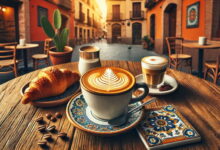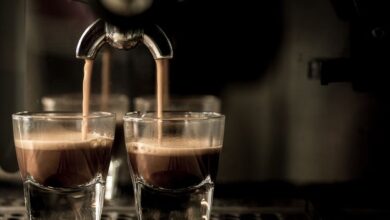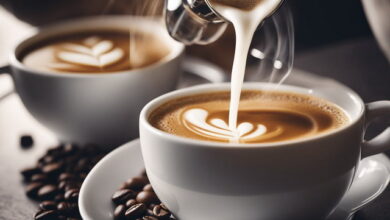The most complete guide to coffee types: from variety and roast to recipes
The most complete guide to coffee types
Do you order a standard cappuccino so as not to waste time and not to understand the endless coffee menu? Do you buy “just beans” and are constantly upset that you again did not hit the desired taste? Do you think that coffee is only grain, ground and instant? The experts of coffee will help you understand the classification of coffee and the methods of its preparation. After reading this article, you will definitely find coffee that you like and learn how to prepare it correctly.
Where does coffee bean come from
Let’s start with the origins. There are more than 90 species of plants of the genus Coffea in nature, but only four species are specially grown, and only two of them are used on an industrial scale.
Arabica
The most popular type of coffee with many varieties bred by man. Arabica is a coffee classic with a rich, interesting taste, natural sourness and sweetness. However, Arabica itself is not very rich in caffeine (1-2% of the total chemical composition), so it is often mixed with Robusta.
The name “Arabica” has a geographical origin – people began to grow this type of coffee on the Arabian Peninsula in the 14th century.
Robusta
It does not taste as good as Arabica and has a characteristic bitterness. But Robusta is very invigorating: it has 2 times more caffeine than its famous sister. This type of coffee is also good for its endurance: where delicate Arabica dies from temperature changes and diseases, Robusta easily bears fruit. In general, if you are looking for a really strong coffee, then either pure Robusta or a mixture of Arabica and Robusta, with the latter content of at least 30%, will suit you.
Liberica
Liberica has been heard of by many, but seen by few, although it is considered potentially very interesting in the coffee world. Liberica’s main advantage is its amazing aroma, for which it is grown: essences from Liberian coffee are loved by the confectionery industry. But, for example, in Malaysia, it is more popular than Arabica and Robusta combined.
Excelsa
An even rarer coffee tree grown in Africa and Southeast Asia. It is both loved and disliked at the same time for its fruity and slightly “perfumy” taste with a hint of sourness. It is almost impossible to find pure excelsa in stores, but it is sometimes found in mixtures with Arabica.
Popular coffee varieties
There are about a thousand cultivated varieties of coffee, but they are all subspecies of Arabica and Robusta, or hybrids of them. The most common are several subspecies of Arabica, which, when grown in different conditions, often produce completely different tastes.
Typica
A difficult to cultivate and capricious variety of coffee, which, with proper care, gives the best results. Among the varieties of Arabica, Typica are the “elite” of the coffee world: Jamaica Blue Mountain, Guatemala, Pluma Hidalgo, Sumatra, Kent, Java, etc.
The main feature of Typica is its natural sweetness and lack of bitterness.
Bourbon
A natural mutation of the Typica with rich fruit flavors and complex acidity. The most famous varieties of bourbon are Ibairi, Jackson, Arusha, Yellow, Red, Orange, Pink Bourbon.
Mocha
One of the oldest types of Arabica, not bred by man, but formed by nature. Mocha has small beans, which when roasted produce a rich taste with spicy notes and a slight spiciness.
Maragogype
Maragogype originated from the common Typica. The main difference of this variety is its huge grains, which are almost 3.5 times larger than the grains of Typica. Maragogype always has a light chocolate note in its taste.
Single-origin and blended coffee
All coffee presented in stores is divided into single varieties and blends. The advantage of single varieties is that you can feel the peculiarity of the taste of each individual variety and choose your favorite one. The advantage of blending is to harmoniously emphasize the positive properties of each component of the blend and create a product of stable quality.
Types of coffee by processing method
Although the end consumer may rarely learn about the method of processing the coffee berry, the processing greatly influences the final taste of the drink.
Dry (natural) processing is often used to reduce the cost of the process. In this case, the berries are simply dried in the sun on a concrete or brick surface until they turn into something like raisins. After that, the outer layers are peeled off, and the beans are sold. Correctly performed processing gives the coffee a sweet taste of berries and fruits. Incorrectly performed – an earthy taste.
Washed processing involves extracting the beans from the berries using special equipment, but not cleaning them from the sticky shell. In this form, they are placed in fermentation tanks for 1-2 days, and then washed with clean water and dried. Almost all specialty coffee is processed this way.
Honey (semi-washed processing) is the result of experiments by technologists. The process is different in different countries. The difference with washed is that less water is spent on processing. The taste of the finished drink is sweeter.
Types of coffee by roasting method
The taste of finished coffee is a combination of natural data (variety and growing conditions) and roasting.
There are quite a few varieties of coffee by roasting method. In different sources you can find French, Italian, American, Viennese, but by and large, all types of roasting can be divided into 3 categories.
Light
Light roasting is roasting until the first crack. Such beans are light brown in color, and there are no traces of oils on their surface. Light roasting is good because it preserves the natural taste of the beans with fruity notes and sourness as carefully as possible. However, there is a downside: if the beans are not the best to begin with, such roasting will highlight all the shortcomings. Best suited for alternatives: Chemex, pour-over, French press.
Types of light roast: cinnamon, light, New England, etc.
Average
Universal roast at a temperature of 210 to 225 degrees. The beans are chocolate-colored, still without oil spots on the surface. Medium roast is ideal for lovers of the classic taste of coffee. Such beans can be prepared in any way.
Types of medium roast: American, city, full city, etc.
Dark
Roasting at a temperature of 230 to 250 degrees. It is good because it hides the shortcomings of the original grain. It is bad because it does not allow the natural taste of coffee to open up and is suitable, by and large, only for espresso.
Types of dark roast: French, Italian, Spanish.
Types of coffee by grinding degree
Different grinds are suitable for different coffee brewing methods. The basic rule is: the finer the fraction, the faster the coffee extraction will occur.
The finest grind, “to dust,” is for a cup into which hot water has been poured.
For the cezve, a fine grind is also used, but it feels similar to particles of sea sand.
Medium grind is used for geyser coffee makers and coffee machines.
Coarse grind – for French press.
Methods of brewing coffee
Actually, all coffee brewing methods are divided into 2 main types: preparation in a coffee machine (espresso and all its derivatives) and alternative. Let’s talk about them in more detail.
Espresso and its derivatives
Since the invention of the first coffee machine and the creation of the espresso recipe, the coffee world has changed. Engineer Luigi Bezzera, who invented the espresso machine in 1901, did not suspect that a century later his brainchild would live in every coffee shop in the world.
Espresso is a drink obtained by passing hot water through a filter with ground coffee under high pressure. The classic recipe requires 7 g of coffee per 30 ml of water. The resulting strong, aromatic and dense coffee can be used as a basis for other recipes.
Americano is an espresso to which 90 ml of hot water has been added.
Lungo is also a type of espresso. However, more water passes through the standard “tablet” with ground coffee. The extraction process also takes longer, so the coffee turns out slightly bitter.
Ristretto is a type of thick and rich espresso, in which 15-20 ml of water is used for a standard 7 g of coffee.
Cappuccino is an espresso with the addition of milk whipped into a smooth, beautiful foam. Milk whipped with a cappuccino maker is sometimes added to coffee. If you don’t have a cappuccino maker at home, you can whip milk using a regular French press.
Latte is espresso with milk. Unlike cappuccino, coffee is added to milk.
Raf is a coffee invented in Moscow and named after a client of one of the capital’s coffee shops, Raphael. In addition to the same espresso, it contains liquid cream and sugar (often replaced with syrups). Video recipe for lavender raf with coconut milk.
And be sure to try this lavender raf with coconut milk from our tea taster Natalia Prokhorenko
Macchiato is espresso with milk, where the milk is not poured in, but rather added with a spoon to form a circle with a coffee rim.
Affogato and glacé are espresso with ice cream. In the first case, coffee is poured over a scoop of ice cream, and in the second, ice cream is added to the coffee.
Con panna is an espresso topped with whipped cream. Viennese coffee is made in a similar way.
Alternative ways to brew coffee
Alternative (or slow-coffee) – all methods of making coffee except a coffee machine.
A cezve is a traditional vessel for making coffee, known since the times of the Ottoman Empire. It came to Russia during the Russo-Turkish wars and was called a “turka”. Making coffee in a cezve is easy, it is inexpensive and suitable for anyone. We wrote more about how to choose a cezve here >>
A French press is a popular coffee brewing device and a perfect find for the lazy and those who love Specialty. How to choose a French press and brew really tasty coffee in it, you can read here >>
The geyser coffee maker (moka) is the most popular coffee maker in Italy. Inventor Alfonso Bialetti claimed to have found a way to make espresso in any kitchen, but coffee made in a moka will still taste different from coffee made in a coffee machine. Read more in this article >>
Chemex is almost a chemistry lab in the kitchen. Chemex is a glass vessel with a funnel, shaped like a watch. It is considered the best option for making specialty coffee because it allows the natural flavor to unfold.
A pour-over is a compact funnel-shaped cup that comes with disposable or reusable filters. Hot water is poured through ground coffee in a spiral. The result is a drink with a soft and pleasant taste. See how it happens:
Cold brew is both the name of the drink and the method of making coffee. It differs in that freshly ground coffee is poured with cold water and infused for 8 to 24 hours, depending on the taste and strength you want to get in the end. Read our article to find out how to brew cold brew correctly.
Recipes for making coffee drinks
All coffee recipes are divided into 2 types: hot and cold.
Hot coffee drinks
Espresso and all drinks made from it, coffee prepared in a Turk and other alternative methods, as well as coffee alcoholic cocktails, such as Irish coffee, are served hot.
Each classic recipe has its own characteristics: from choosing the right roast and grind of beans to the water temperature, the time of preparation of the drink and various additives that better reveal the taste of coffee. For example, if you brew coffee in a Turk, try adding a pinch of salt to it:
When making coffee in a geyser coffee maker, use hot water instead of cold water – this way the drink will be more aromatic and will not be over-extracted.
Cold coffee drinks
Cold coffee drinks can vary in the way they are prepared. Cold brew and nitro coffee (carbonated cold brew) are initially steeped in cold water. Iced latte, frappe, and Vietnamese coffee (also popular throughout Southeast Asia) are made from chilled coffee, to which ice and cold milk are added.
The coffee itself in Vietnam is prepared in a special press-fin, using, as a rule, robusta or blends with a high robusta content. This unique device with two filters allows you to prepare coffee by dripping, directly into the cup:
Frappe is instant or ground coffee whipped with milk, sugar and ice.
Made popular by Starbucks, the iced latte is a drink made from chilled espresso, milk, syrup, and ice, hand-blended in a glass or shaker.
By the way, there is a myth that hot coffee affects the body more effectively than cold coffee. But this nuance depends only on your personal preferences (and the time of year when you drink coffee). The amount of caffeine and its effect on your body does not depend on the temperature of the drink.







